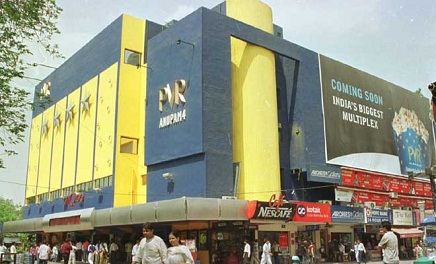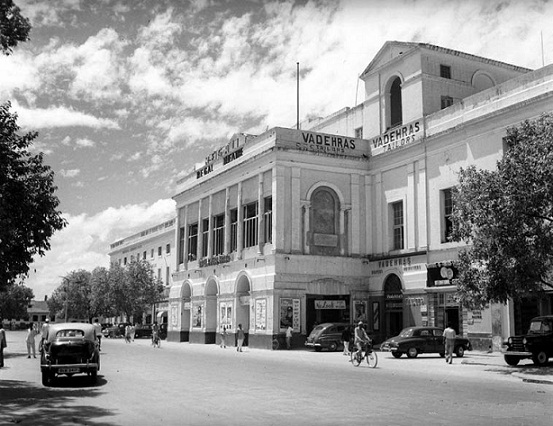Delhi: Cinema halls/ theatres

Chanakya would underscore the bigness of its screen by beginning the screening of Cinemascope and 70mm films on about three quarters of the screen, leaving a blank, white border or rim on all four sides. It was Chanakya’s way of saying: This is how big other cinemas’ widescreen is. Then it would expand the image to cover the whole screen, under the name Chanakyarama.
By 1972 it started projecting normal 35mm films on its widescreen, under the name Chanakyascope. This of course meant cropping off the top and bottom of the image, but Delhiites were delighted.
In 1975 it installed an early version of surround sound (popularised in India by Dolby in the 1990s.)

Chanakya got off to an inauspicious start in 1970 with Mera Naam Joker, which was the most keenly awaited film since Sangam (1964), bombing so badly that it had to be taken off after a week.
Cromwell was, in 1971, the first film to be screened in Chanakyarama.

That distinction had been grabbed as many as 33 years before, in 1964, by the 3-screen Sapphire, Emerald, Blue Diamond: Chennai/ Madras.
indeed, by the 1970s, two-screen theatres were commonplace in Bangalore, Hyderabad and Madras.
These are newspaper articles selected for the excellence of their content.
Additional details may kindly be sent as messages to the Facebook page, Indpaedia.com. Indormation used will be acknowledged in your name. |
Contents |
Source article
New cinema scene in Delhi
By Namya Sinha, Hindustan Times, October 07, 2011 Hindustan Times </div>
Delhi’s cinema halls
1930s
Lights camera action: Regal cinema opened in 1932 in Connaught Place. In 1933, Plaza Cinema opened nearby. In 1939, Moti Hall in Old Delhi revamped itself from being a venue for live theatre performances to a movie hall that screened Bollywood talkies
1940
Old Delhi is cinema central: As talkies became more and more popular, eight to nine movie halls opened up in Old Delhi around this time, including Ritz, Novelty, Jagat and Kumar Talkies. They were referred to as ‘bioscope’ or ‘mandwa’ and known by the area they were located in
1950s
Comfort cinema: Delite Cinema and Golcha opened in 1954 in Old Delhi.
Delite was the first air conditioned hall in North India. Its foyers had the look and feel of pre-1947 British/ Maharaja-style luxury.
In 1956, Eros Cinema opened in Jungpura. “At that time, movies ran for 50-60 weeks. But now, people get a lot of TV channels, so films hardly last for 4 weeks,” says NR Saini, the owner of Golcha
[Not quite true. Even at their peak, only one or two films in a year would run for 50-60 weeks, and that in Bombay. Delhi's much smaller market would at best stretch films to 25 weeks. Sholay and Hum Aapke Hain Koun? Were among the few golden jubilees in Delhi.]
1960s
70mm in town: The Sheila movie hall, which opened in Paharganj in 1961, was India’s first 70 mm theatre.
Odeon expands its screen to 70mm and even conducts an unsuccessful trial run of Cinerama with 'How the West Was Won' in 1965.
Liberty, located in non-English speaking West Delhi, also installed 70mm equipment and a widescreen. This was unusual for a hall that never screened English films. However, as a reward it got to screen both Around the World (1967) and Sholay (1975): two 70mm films in a decade.
English films
Tiny Rivoli followed the all-India pattern of medium-sized halls in localities popular during the British Raj screening only English films. Shiela (Delhi’s biggest, till Vishal came along) and Odeon would screen both English and Hindi-Urdu films.
In ‘old’ Delhi, Delite alone would screen English films (including European art cinema) in normal shows, i.e. after 12 noon. Throughout India, in the state capitals as well as in the non-English speaking parts of the metropolitan cities, some cinemas that otherwise catered to films in the local language or Hindi-Urdu, would screen English films in the 10am show on Sundays (sometimes, Saturdays as well).
By the 1970s, South Delhi, where house owners mostly spoke English, started beginning to count, vis a vis cinema central (old Delhi, with its huge but not affluent population) and the then swank central Delhi.Therefore, English films moved to Chanakya and then Archana, Greater Kailash.
India was a very tiny market for English films, and would get them after they had run their course in small East Asian, ASEAN and Latin American countries. Within India, Bombay, Bangalore, Madras, Hyderabad and Calcutta had bigger English-speaking audiences than in Delhi/ North India (with the lowest literacy in India). Except for dubbed European films with lots of cheesecake, an English film would be released at only one hall at a time in Delhi, or even the other metros. ('That Man in Istanbul' was released at 4 Delhi theatres simultaneously.)
The trend of releasing the same English film at a dozen or more halls within the national capital region is a 21st century trend, and a result of the post-1992 liberalisation and the consequent sudden increase in employment opportunities for English-speaking youths.
1970s
Single in the city: In 1970, Chanakya Cinema and Vishal Cinema opened. With a seating capacity of 1,400 people, Vishal was the largest movie hall in [Delhi].
Plaza goes 70mm only around 1970 and specialises in Russian (i.e. Soviet) blockbusters. Delhi’s longest running non-Indian film, screened at Plaza, was 'Gypsy camp vanishes into the blue' (USSR), because it had a topless scene.
1980s
Cinema goes west: Satyam [later, Cineplex] opened in 1980. It was the first movie theatre in Patel Nagar in West Delhi
1990s
Being single: In the early 1990s, there were only single screen halls in the Capital until the first multiplex of Delhi Anupam PVR Cineplex, opened in Saket in the year 1997. [All three South Indian metros have had two-screen cinemas since the 1970s. The 3-screen Blue Diamond, Sapphire, Emerald multiplex in Madras/ Chennai was without doubt India’s first multiplex and opened in the 1960s.]
2000s
Multiplexes boom: This decade was marked by the end of single screen halls. In 2007, iconic Delhi theatre, Chanakya Cinema, also shut down. Odeon cinema became a part of Big Cinemas and now has two screens. Alankar Cinema in Lajpat reopened as 3Cs in 2002
The first Imax hall of the national capital region, Aeren Adlabs, opens in Kaushambi but does badly because of its location. And yet it got 'Superman III' (partly in 3D) almost a day before its US release. (Aeren R IMAX Theatre at Rap Adlabs Multiplex, Pacific Mall, Sahibabad, opened in 2005.)
2010s
Director’s Cut, which opened in 2011 on the 3rd floor of Ambience Mall, Vasant Kunj, Delhi, was the most expensive theatre of its time—more than twice as expensive as the next costliest. It has a restaurant. The bookstore came in when the owners considered what all would a movie lover want.
The four auditoriums have different seating capacities, with the smallest being 25 people. These can be booked by people for private screenings of movies from a collection of 300 select films. The halls will also screen the latest flicks. There’s another concept called Director’s Rare, under which, two shows per day will be dedicated to rare, vintage or award-winning films from all over the country and world. The reclining chair in the auditoriums have a push button, which on pressing, will instruct a server to come with an iPad menu. The orders are directly recorded in the kitchen and delivered to your seat.
The restaurant and shops are open to those who don’t want to watch a movie, but simply want to hangout and soak in the cinema.
Tickets: Weekdays: Morning (Rs 600), Evening (Rs 850), Weekend (Rs 1,050)
Aerated drinks: Rs100 (plus taxes)
Popcorn: Rs. 120 - Rs. 130 plus taxes
Meal for two in the restaurant: Rs. 2,000 (approx)
See also
Delhi: Cinema halls/ theatres / Madras/ Chennai theatres/ cinemas / PVR (Priya Village Roadshow) group / Sapphire, Emerald, Blue Diamond: Chennai/ Madras /

